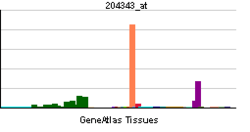ABCA3
| View/Edit Human | View/Edit Mouse |
ATP-binding cassette sub-family A member 3 is a protein that in humans is encoded by the ABCA3 gene.[3][4]
The membrane-associated protein encoded by this gene is a member of the superfamily of ATP-binding cassette (ABC) transporters. ABC proteins transport various molecules across extra- and intracellular membranes. ABC genes are divided into seven distinct subfamilies (ABC1, MDR/TAP, MRP, ALD, OABP, GCN20, White). This protein is a member of the ABC1 subfamily. Members of the ABC1 subfamily comprise the only major ABC subfamily found exclusively in multicellular eukaryotes. The full transporter encoded by this gene may be involved in development of resistance to xenobiotics and engulfment during programmed cell death.[4]
Clinical significance
Mutations in ABCA3 are associated to cataract-microcornea syndrome .[5]
It is associated with Surfactant metabolism dysfunction type 3.
See also
References
- ↑ "Human PubMed Reference:".
- ↑ "Mouse PubMed Reference:".
- ↑ Klugbauer N, Hofmann F (Sep 1996). "Primary structure of a novel ABC transporter with a chromosomal localization on the band encoding the multidrug resistance-associated protein". FEBS Lett. 391 (1–2): 61–5. doi:10.1016/0014-5793(96)00700-4. PMID 8706931.
- 1 2 "Entrez Gene: ABCA3 ATP-binding cassette, sub-family A (ABC1), member 3".
- ↑ Chen, P; Dai, Y; Wu, X; Wang, Y; Sun, S; Xiao, J; Zhang, Q; Guan, L; Zhao, X; Hao, X; Wu, R; Xie, L (2014). "Mutations in the ABCA3 gene are associated with cataract-microcornea syndrome". Investigative Ophthalmology & Visual Science. 55: 8031–43. doi:10.1167/iovs.14-14098. PMID 25406294.
Further reading
- Connors TD, Van Raay TJ, Petry LR, et al. (1997). "The cloning of a human ABC gene (ABC3) mapping to chromosome 16p13.3". Genomics. 39 (2): 231–4. doi:10.1006/geno.1996.4500. PMID 9027511.
- Yamano G, Funahashi H, Kawanami O, et al. (2001). "ABCA3 is a lamellar body membrane protein in human lung alveolar type II cells". FEBS Lett. 508 (2): 221–5. doi:10.1016/S0014-5793(01)03056-3. PMID 11718719.
- Mulugeta S, Gray JM, Notarfrancesco KL, et al. (2002). "Identification of LBM180, a lamellar body limiting membrane protein of alveolar type II cells, as the ABC transporter protein ABCA3". J. Biol. Chem. 277 (25): 22147–55. doi:10.1074/jbc.M201812200. PMID 11940594.
- Strausberg RL, Feingold EA, Grouse LH, et al. (2003). "Generation and initial analysis of more than 15,000 full-length human and mouse cDNA sequences". Proc. Natl. Acad. Sci. U.S.A. 99 (26): 16899–903. doi:10.1073/pnas.242603899. PMC 139241
 . PMID 12477932.
. PMID 12477932. - Shulenin S, Nogee LM, Annilo T, et al. (2004). "ABCA3 gene mutations in newborns with fatal surfactant deficiency". N. Engl. J. Med. 350 (13): 1296–303. doi:10.1056/NEJMoa032178. PMID 15044640.
- Nagata K, Yamamoto A, Ban N, et al. (2004). "Human ABCA3, a product of a responsible gene for abca3 for fatal surfactant deficiency in newborns, exhibits unique ATP hydrolysis activity and generates intracellular multilamellar vesicles". Biochem. Biophys. Res. Commun. 324 (1): 262–8. doi:10.1016/j.bbrc.2004.09.043. PMID 15465012.
- Wulf GG, Modlich S, Inagaki N, et al. (2006). "ABC transporter ABCA3 is expressed in acute myeloid leukemia blast cells and participates in vesicular transport". Haematologica. 89 (11): 1395–7. PMID 15531465.
- Kimura K, Wakamatsu A, Suzuki Y, et al. (2006). "Diversification of transcriptional modulation: Large-scale identification and characterization of putative alternative promoters of human genes". Genome Res. 16 (1): 55–65. doi:10.1101/gr.4039406. PMC 1356129
 . PMID 16344560.
. PMID 16344560. - Cheong N, Madesh M, Gonzales LW, et al. (2006). "Functional and trafficking defects in ATP binding cassette A3 mutants associated with respiratory distress syndrome". J. Biol. Chem. 281 (14): 9791–800. doi:10.1074/jbc.M507515200. PMID 16415354.
- Steinbach D, Gillet JP, Sauerbrey A, et al. (2007). "ABCA3 as a possible cause of drug resistance in childhood acute myeloid leukemia". Clin. Cancer Res. 12 (14 Pt 1): 4357–63. doi:10.1158/1078-0432.CCR-05-2587. PMID 16857811.
- Matsumura Y, Ban N, Ueda K, Inagaki N (2006). "Characterization and classification of ATP-binding cassette transporter ABCA3 mutants in fatal surfactant deficiency". J. Biol. Chem. 281 (45): 34503–14. doi:10.1074/jbc.M600071200. PMID 16959783.
- Piehler AP, Wenzel JJ, Olstad OK, et al. (2006). "The human ortholog of the rodent testis-specific ABC transporter Abca17 is a ubiquitously expressed pseudogene (ABCA17P) and shares a common 5' end with ABCA3". BMC Mol. Biol. 7: 28. doi:10.1186/1471-2199-7-28. PMC 1579226
 . PMID 16968533.
. PMID 16968533. - Saugstad OD, Hansen TW, Rønnestad A, et al. (2007). "Novel mutations in the gene encoding ATP binding cassette protein member A3 (ABCA3) resulting in fatal neonatal lung disease". Acta Paediatr. 96 (2): 185–90. doi:10.1111/j.1651-2227.2007.00016.x. PMID 17429902.
- Matsumura Y, Sakai H, Sasaki M, et al. (2007). "ABCA3-mediated choline-phospholipids uptake into intracellular vesicles in A549 cells". FEBS Lett. 581 (17): 3139–44. doi:10.1016/j.febslet.2007.05.078. PMID 17574245.
- Bullard JE, Nogee LM (2007). "Heterozygosity for ABCA3 mutations modifies the severity of lung disease associated with a surfactant protein C gene (SFTPC) mutation". Pediatr. Res. 62 (2): 176–9. doi:10.1203/PDR.0b013e3180a72588. PMID 17597647.
External links
- ABCA3 protein, human at the US National Library of Medicine Medical Subject Headings (MeSH)
- ABCA3 human gene location in the UCSC Genome Browser.
- ABCA3 human gene details in the UCSC Genome Browser.
This article incorporates text from the United States National Library of Medicine, which is in the public domain.
